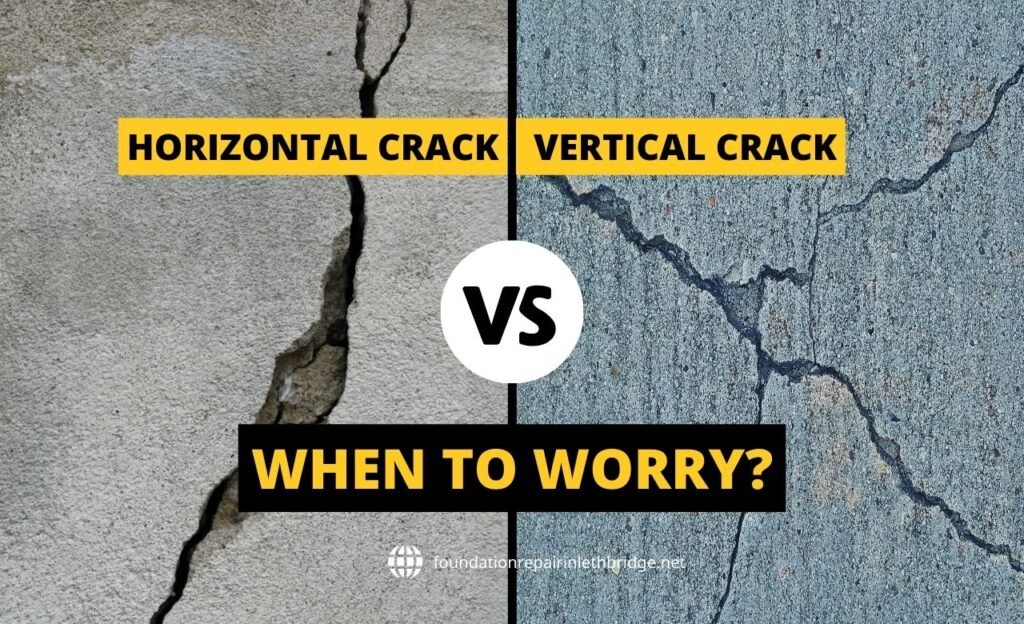Horizontal vs Vertical Foundation Cracks – When to Worry?

Foundation cracks are common in many homes, especially in areas with changing soil, moisture levels, and temperature. But not all cracks mean the same thing. Knowing the difference between horizontal and vertical cracks can help you understand if the issue is minor or something more serious.
In this article, we’ll break down what horizontal and vertical cracks mean, what causes them, and when you should be concerned. We’ve also included a table to help you quickly compare both types of cracks.
What Are Vertical Foundation Cracks?
Vertical cracks run straight up and down or at a slight diagonal angle. These are often found in poured concrete walls and usually appear as the concrete settles.
Causes of Vertical Cracks:
- Normal concrete shrinkage during curing
- Soil settling beneath the foundation
- Minor shifts from temperature changes
When Are Vertical Cracks a Problem?
Most vertical cracks are not serious and can be sealed easily. However, if the cracks are wider than 1/8 inch or keep growing, they may point to ongoing settlement or water pressure from outside.
If you see water leaking through the crack or if it’s visible on both the inside and outside of the wall, it’s time to have it checked by a professional.
What Are Horizontal Foundation Cracks?
Horizontal cracks run side-to-side and are more serious. These cracks often appear in block or poured basement walls and can indicate strong pressure pushing in from outside.
Causes of Horizontal Cracks:
- Water pressure from saturated soil
- Poor drainage around the home
- Expansive soil swelling with moisture
- Frost pressure during freezing weather
When Are Horizontal Cracks a Problem?
Horizontal cracks are usually more dangerous than vertical ones. They often indicate serious pressure from outside the foundation wall and may be an early sign of structural failure.
These cracks are especially dangerous if the wall is bowing or if water is leaking through. Acting quickly can prevent major repairs and protect your home’s structure.
You should worry if:
- The crack is long and runs along a large section of the wall
- You see the wall bowing or bulging inward
- Water is coming through the crack
- The crack keeps growing wider
Horizontal cracks can sometimes mean the wall is slowly moving inward. If left alone, the wall might eventually collapse. These cracks often require structural repairs and should not be ignored.
Quick Comparison: Horizontal vs. Vertical Foundation Cracks
| Feature | Vertical Cracks | Horizontal Cracks |
|---|---|---|
| Common Cause | Concrete shrinkage, minor settlement | Soil pressure, poor drainage, frost |
| Appearance | Runs up-and-down or diagonally | Runs side-to-side across the wall |
| Risk Level | Usually low, if small and stable | High – may indicate structural failure |
| Needs Urgent Repair? | Only if widening, leaking, or expanding | Yes – often needs structural reinforcement |
| Common in | Poured concrete walls | Block or poured basement walls |
Don’t Ignore Warning Signs
Any crack, vertical or horizontal, should be monitored. Take notes on the length and width of the crack, and check if it changes over time. Also, keep an eye out for other signs of foundation trouble:
- Sticking windows or doors
- Uneven floors
- Recommend the right repair solution.
Trying to patch serious cracks yourself could hide deeper issues that only get worse with time.
Expert Foundation Crack Repair in Lethbridge
Everfix Foundation Repair helps Lethbridge homeowners understand and fix all types of foundation cracks. Whether it’s a harmless vertical line or a serious horizontal crack, our team will inspect your foundation and give honest guidance.
Explore our professional Foundation Repair service in Lethbridge, Alberta, to book an inspection or get a repair quote. We’re here to keep your home safe from the ground up.
